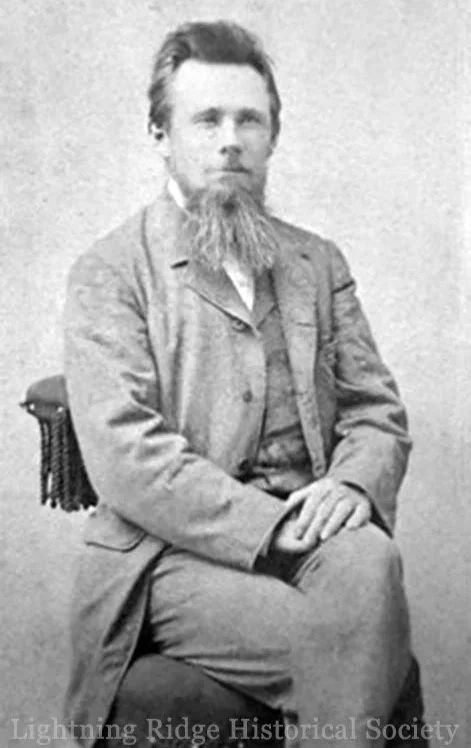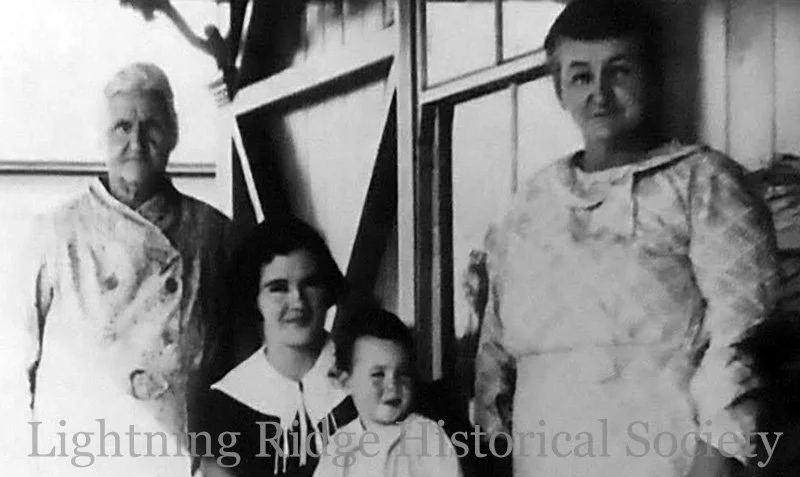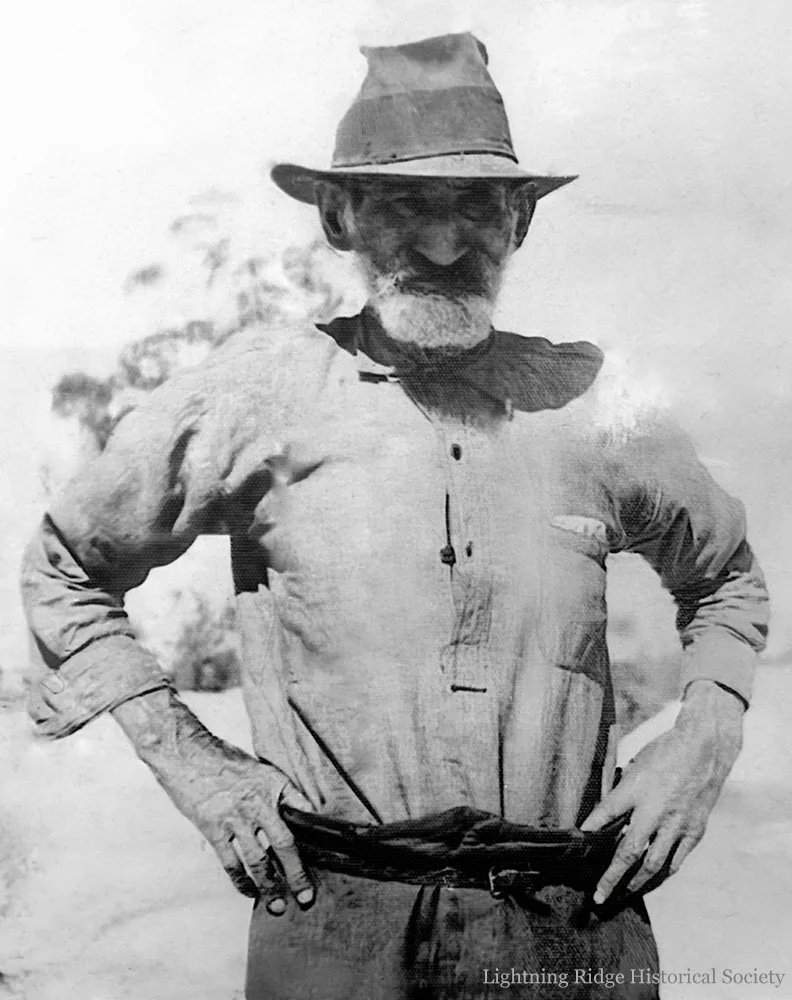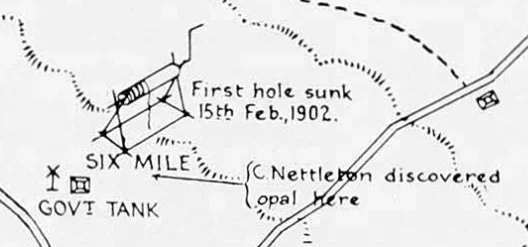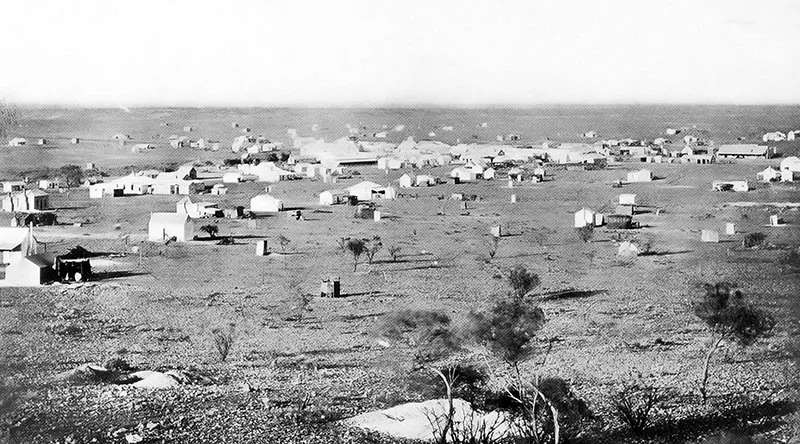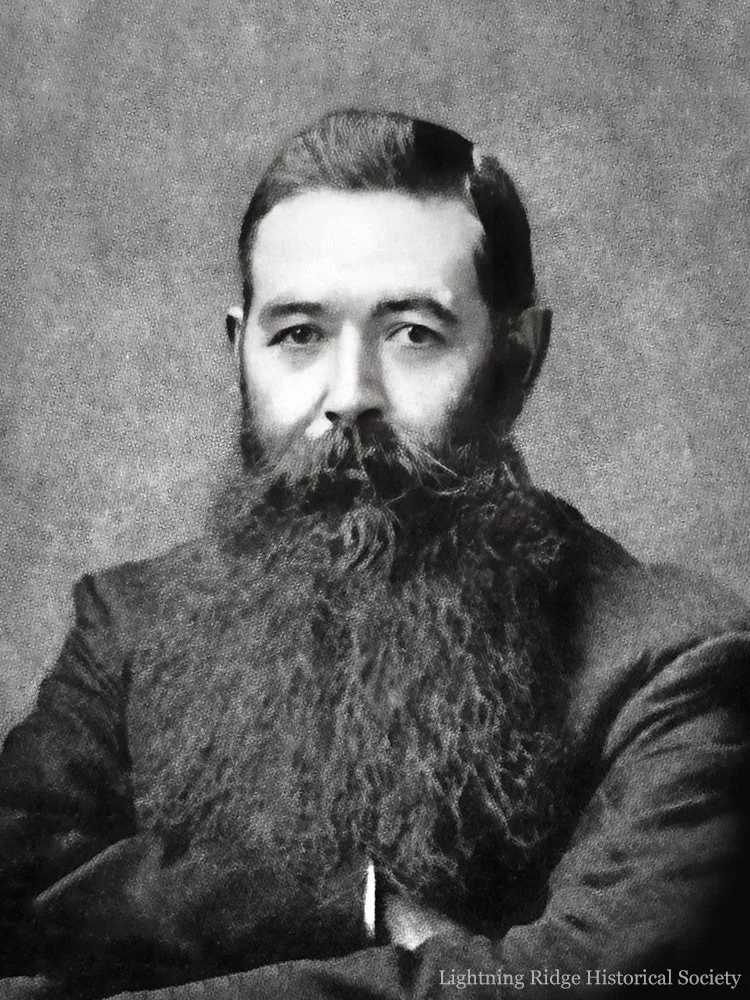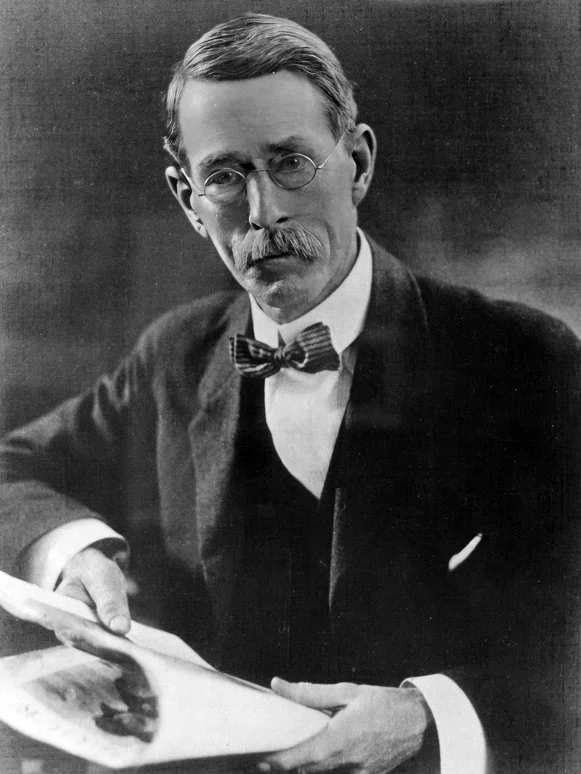The Discovery of Opal at Lightning Ridge
The first people to discover opal at Lightning Ridge were undoubtedly the Yuwaalaraay, Gamilaraay and other First Nations people. Attuned to, and part of Country, Indigenous people encountered opal long before anyone documented in written records.
Opal at Lightning Ridge is found on a series of gravel ridges, which sit above the surrounding plains. Beneath the surface, in the claystone, these ridges bear both precious opal (opal showing play-of-colour) and common opal or potch (colourless opal of little value).
Precious opal, showing play-of-colour.
Common opal or “potch”.
Opal occurs at different levels below the surface. Where the opal level is shallow and the surface has been eroded by wind and rain, surface opal or “floaters” can be found amongst the much younger surface gravel.
Initial Discoveries (1873-1900)
Robert Lismore Moore. Photograph: State Library of New South Wales, reference MLMSS 10304.
In 1873, Robert Lismore Moore became manager of Angledool Station, one of four large pastoral properties that met roughly where Lightning Ridge is now located.
Moore was an avid rockhound with a background in gold and tin prospecting, and he and his family and friends would regularly journey out on the vast Angledool property in search of specimens and pebbles.
Robert Moore’s wife, Francis Emily Mary Moore kept detailed diaries during her time on Angledool Station. In her diaries, she documented daily life on the station, business matters and personal observations. She also documented Robert’s time spent out on the land searching for interesting stones, along with other mineral discoveries made by people working on the station.
Topaz from the Nebea Ridges.
In addition to opal, the surface gravels on the ridges also contain semi-precious stones such as jasper, carnelian, agate, onyx and topaz. The latter was quite sought after by Moore.
It was no doubt on one of these prospecting sojourns prior to 1880 that Moore found the first specimens of Lightning Ridge black opal. He collected the opal, packaged it up and sent the parcel to Sydney for valuation.
The response he received was not encouraging; they were seen to be of very little value indeed.
“ln 1873 or 1874 be sent a “hatful of the pretty stones” from the Nebea Ridges to Sydney to ascertain their value, and whether it was worth-while going on with a mining venture. The reply was it would be worth 70/- per ton in Sydney as road metal.”
Disheartened, Moore did not continue prospecting for opal, nor did he engage in mining activities.
The Beginning of Lightning Ridge
“There are very few people who know that it was a woman, Mrs Ryan, who was the first person to discover black opal at Lightning Ridge.”
Ann Ryan (left) and family. Photograph: Courtesy of Catherine Isabella (Ryan) & Donald Denchar Gunn and their descendants.
Prior to 1902, Ann Ryan, wife of boundary rider Patrick Rowland Ryan accumulated a collection of her own opal specimens, which she found in puddles and streams after rain. She kept them, thinking they were something of a curiosity, unaware of their significance.
Around the same time, Charlie Nettleton was prospecting for gold in the Bathurst region. Nettleton was a gold prospector and an opal prospector, having spent some time on the White Cliffs opal fields in earlier years. Near Bathurst, his prospecting mate had suggested they should head north, as he had heard a rumour of gold on Bangate, a neighbouring station to Angledool Station. Nettleton agreed, and they headed north to investigate. Once they arrived in Walgett, Nettleton and his mining partner split. Alone, Nettleton moved on to Angledool.
Charles Waterhouse Nettleton. Photograph: Family of Dawn Swane, Lightning Ridge Historical Society.
In Angledool town, Nettleton met Mrs. Ryan, who mentioned the unusual stones she had found. Nettleton was intrigued.
Returning to the Ryan’s homestead near Lightning Ridge Tank on the traveling stock route, Ryan showed Nettleton her discoveries, and he immediately recognised the stones as opal - not light opal like the White Cliffs kind, but a strange dark kind of opal.
Recognising value in the material, Nettleton was compelled to prospect further. On Mrs. Ryan’s advice, he prospected up the hill towards what today is McDonald’s Six Mile. Based on government maps, Nettleton sank his first shaft while prospecting on 15 February 1902.
Map notes based on survey conducted by government surveyor O. le M. Knight, published 1953, Australian Museum Magazine, vol. XI, no 3, later published in The Occurrence of Opal at Lightning Ridge and Grawin, with Geological Notes on County Finch, Whiting & Relph, 1958.
On the other side of the ridge, on Dunumbral Station, Jack Murray was working as a boundary rider – mending fences, setting rabbit traps, maintaining the infrastructure of the large property. While setting rabbit traps, he too found surface traces of opal. After rain, his wife Florence and young son Victor – only a toddler at the time – found coloured stones on the ground, collecting them up to play marbles or jacks. Murray continued to search for opal, losing his job as a boundary rider for digging up the land rather than looking after it.
The Syndicate
Joe Beckett of Weetalibah. Photograph sourced from Ancestry records, enhanced with Supir AI.
In the early months of 1903, innkeeper Joe Beckett of the Weetalibah Hotel, also a keen rockhound, started an opal mining syndicate with several station managers from the district, with the purpose of finding black opal and mining it systematically.
Beckett was already familiar with black opal, as he had purchased pieces from visitors passing through his hotel – Beckett is likely to be Lightning Ridge’s first opal buyer, although not in a commercial capacity.
The syndicate comprised Joe Beckett, William Ferris of Gerongra Station, James Armitage of Dunumbral Station, Langloh Parker of Bangate Station, Frank Doucutt who was the bookkeeper for Bangate Station, and a Collarenebri storekeeper whose identity remains unknown. Robert Moore, still manager of Angledool Station at the time, is conspicuously absent from the roster – likely still burned from his previous experience with poor opal valuation in Sydney. The syndicate employed two additional people: a geologist from Sydney to provide expert advice on where to dig for opal, and Charlie Nettleton to do the digging.
Nettleton was paid to sink a shaft once again on McDonald’s Six Mile, in a location of the geologist’s choosing. He may have worked with Dan O’Connor as an offsider. The hole was sunk by hand to a depth of 50 feet, and produced no opal whatsoever.
Very shortly after, the syndicate disbanded and Nettleton continued working on his own.
Nettleton and Murray
Jack Murray. Photograph: Lightning Ridge Historical Society.
Hearing of the discoveries of Jack Murray and his family, Nettleton moved over to the Dunumbral side of the ridge, and worked with Murray on Sim’s Hill (the location of the Wallangulla [Old Town] settlement) and the opal field now known as Old Nobby.
Working together, they gathered a parcel of opal and in a similar effort to Robert Moore some 30 years earlier, packaged them up and sent them to Sydney. Again, the valuation was poor and the Sydney buyer’s offer was rejected.
“After what was probably a long and anxious wait for all of them—for Nettleton was the only one who knew opal and he didn’t fancy the colour of this dark horse very much-back came the generous offer of the opulent buyer: ten shillings for the lot, no more!”
The Walk to White Cliffs
White Cliffs township in the early years.
Nettleton formulated a new plan – to take the parcel of opal to White Cliffs to show it to some opal buyers he personally knew from his time at the Cliffs.
The walk to White Cliffs was long, arduous and difficult. Roughly 500 kilometres as the crow flies, and in the October-November heat.
Some of the journey was taken up on paddle steamers from Brewarrina or Bourke, but the majority was on foot. The walk took about a month. Nettleton’s contact, E. F. Murphy, describes the arrival in his book They Struck Opal! From 1948:
“On 11 November, 1903, Charlie Nettleton, prospector of the Lightning Ridge opal field, came to me at White Cliffs with a parcel of opal of an entirely new variety-very dark, although it did have some good colour. He had sent 100 ounces to Sydney, and been offered 10s. for it, its being considered too dark for commercial value. Personally, I thought the stuff had possibilities, and wanted Mr Wollaston to see it, so I bought it.”
E. F. “Ted” Murphy.
Tullie “T. C.” Wollaston.
Murphy was operating on behalf of Tullie Wollaston, an Adelaide opal buyer and promoter. Between them, Murphy and Wollaston are responsible for the first purchase of a parcel of Lightning Ridge black opal — and with that, the doors of possibility were opened.
When Nettleton returned to Lightning Ridge, he was followed back by a crowd of White Cliffs miners. The opening up of the Lightning Ridge opal fields was a godsend for them as the Cliffs were “drying up” in 1903, and they were eager for the new opportunity. Among the White Cliffs miners to move over to The Ridge in 1903 were Bob Buckley and Peter Ferguson.
E. F. Murphy would also follow on to Lightning Ridge, first visiting in 1905 and becoming a resident opal buyer in 1906. Thanks to Murphy’s meticulous ledgers, we know he continued to buy opal from Jack Murray for many years to follow, purchasing many “walnuts” (Murphy’s terminology for what we now call nobbies) from Murray and others.
Robert Moore, Frances Moore, Ann Ryan, Jack Murray, Charles Nettleton, Ted Murphy.
We recognise Robert Moore, Frances Moore, Ann Ryan, Jack Murray, Charles Nettleton, Joe Beckett, Ted Murphy and T. C. Wollaston — among others — for their contributions to the earliest history of our opal mining industry and community. Each contributed to the discovery, identification and commercialisation of Lightning Ridge black opal in 1903 and set Lightning Ridge on its way to being the Home of the Black Opal, the Black Opal Capital of the World and source of New South Wales’ state gemstone.
Article: Research by Russell Gawthorpe and Leisa Carney, edited by Russell Gawthorpe. LRHS research compiled by Len Cram and Barbara Moritz. Sources: Marriage certificate, Australian Marriage Index, ref. 3767/1882; Frances Emily Mary Moore diaries, 1880-1922, reference 9641502, SLNSW, 17 June 1885; 17 April 1886; 27 April 1886, 28 June 1903; New South Wales Collector’s Book, Census 1901, p. 6, line 2; Walgett Spectator, 14 March 1903; ‘Mining in the State’, The Sydney Morning Herald, 22 October 1903, p. 9; J.M. Landers, Walgett Spectator, 10 November 1921; J. Drayton, ‘Real Opals in the Ring’, Smith’s Weekly, 26 May 1923, p. 29; ‘Court of the Flame Queen’, Daily Standard, 14 June 1935, p. 4; ‘Pioneer of Outback Tells of Roaring Days of White Cliffs Opal’, Barrier Miner, 24 April 1946, p. 3; ‘New South Wales Opal Fields’, Australian Museum Magazine, 15 September 1953, vol. 11, no. 3, p. 86; The Occurrence of Opal at Lightning Ridge and Grawin with Geological Notes on County Finch, J.W. Whiting & R.E. Relph, 1958, p. 12; The Opal Book, Frank Leechman, 1961, pp. 70, 72; The Lightning Ridge Book, Stuart Lloyd, 1967, pp. 11, 88-89, 138; Beautiful Lightning Ridge and History, Len Cram, 1996, pp. 3, 5; A Journey With Colour: A History of Lightning Ridge Opal 1873-2003, Len Cram, 2003, pp. 12-13, 15-16.


